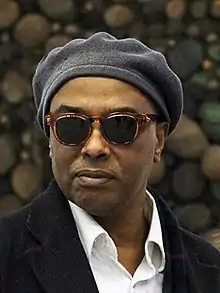Fathi Hassan
Fathi Hassan (Arabic: فتحي حسن) (born 10 May 1957) is an Egyptian-born, Italian-based artist known for his installations involving the written word.[3]
Fathi Hassan فتحي حسن | |
|---|---|
 | |
| Born | 10 May 1957[1] |
| Nationality | (Egyptian/Sudanese) |
| Education | Accademia di Belle Arti di Napoli (1984)[2] |
| Known for | Painting, sculpture, installation art |
| Website | fathihassan |
Life
Fathi Hassan was born in Cairo in 1957 as the second son to a Nubian family.[2][1] His father Hassan was Sudanese and his mother Fatma was from the Toshka Lakes region in southern Egypt.[2] He studied art as a teenager at Cairo's Kerabia School where he was taught by the sculptor Ghaleb Khater.[2][3] In 1976, Hassan worked for some months at the Madbuli Library in Cairo. In 1977 the Ministry of Culture (Egypt) offered him a job in Baghdad where he met Kadhim Hayder. In 1978 he returned to Cairo.[4]
Work
In 1979, Hassan received a grant from the Italian Cultural Institute in Cairo and moved to Naples.[2][3][1] He enrolled at the Accademia di Belle Arti in 1980 to study set design.[1] He graduated in 1984 with a dissertation on the influence of African art in Cubism.[1] While he was studying and in the year after graduation, Hassan also worked as an actor and set designer at RAI (Radiotelevisione Italiana works) in Naples and Rome.[1] In 1986, he moved to Pesaro.[1]
In 1989 Hassan was the first artist of African heritage to be invited to the "Aperto" section of the 43rd Venice Biennale curated by Dan Cameron and Giovanni Carandente. He has exhibited in numerous galleries in Italy, Belgium, Denmark, Germany, France, Egypt, and United States.,[5] International TV "UNINETTUNO" telematic university, presents, transmission on the theme "inside L, soul".
Hassan's work often emphasizes power dynamics and the relationship between the oral and written word; drawing from his Nubian heritage, he places particular emphasis on the loss of language under the dominance of colonialism. Most of his scripts are based upon kufic calligraphy, but remain deliberately illegible and impossible to decipher. In his video Blessed Nubia (2002) is an analysis of the original language of Nubia.[6]
Hassan has lived and worked in Italy since 1979, dividing his time between Rome, Milan and Fano.[3][7][8] In 2011 Hassan started spending more time in Edinburgh, where he owns a studio.[9]
Further reading
- Eriberto Eulisse (2001). Images of Writing, Writing of Images: The Work of Fathi Hassan. Nka Journal of Contemporary African Art. Fall/Winter 2001 (15): 30-37. doi:10.1215/10757163-15-1-30
- Achille Bonito Oliva (2000). Fathi Hassan (exhibition catalogue). Milan: Charta Art Books. ISBN 9788881582846.
- Mary Angela Schroth, Sandra Federici, Andrea Marchesini Reggiani (2000). TransAfricana: artisti contemporanei: Bologna, 15 gennaio–24 febbraio 2000: San Giorgio in Poggiale, Collezioni d'arte e di storia della Fondazione Cassa di Risparmio di Bologna (exhibition catalogue). Bologna: Lai-momo. Pages 47–49, 72–73. (full record)
- Roberto Bencivenga (2002). Fathi Hassan: la sostanza dell'anima = Spirit Matter (exhibition catalogue). Senigallia: Ed. Della Rovere. (no ISBN?).
References
- Goncharov, Kathleen. "Biografia e lavori di Fathi Hassan, Akkij" (in Italian and Arabic). Fathi Hassan. Archived from the original on 2 May 2009. Retrieved 19 October 2010.
- Hassan, Fathi (2006). "Fathi Hassan". Fathi Hassan. Archived from the original on 5 August 2010. Retrieved 18 October 2010.
- Exhibitions. Leighton House Museum; The Royal Borough of Kensington and Chelsea. Archived 29 November 2010.
- https://www.graficamanzoni.it/index.php/arte/manufacturers/fathi-hassan
- teranet.it, TeraNet Srl. "Biography - Fathi Hassan - Artists and Works - ARTantide.com". www.artantide.com. Retrieved 2018-02-28.
- "Oversea, art from mediterranean". Archived from the original on 2009-04-29. Retrieved 2010-10-23.
- Kathleen Goncharov (2007). Fathi Hassan: Cultural Nomad. In: Micaela Nardi (editor) (2007). Fathi Hassan: Safir (exhibition catalogue). Senigallia: Ed. Della Rovere. Archived 2 April 2009.
- "Textures: Word and Symbol in Contemporary African Art – Fathi Hassan". National Museum of African Art. Retrieved 19 October 2010.
- http://www.sistersgrace.it/pages/fathi_hassan.html
- Abdel-moniem El-Shorbagy, Hassan Fathy: The Unacknowledged Conscience Of Twentieth Century Architecture. A paper published in the International Journal of Basic & Applied Sciences IJBAS-IJENS Vol:10 Issue: 02, 10 April 2010.
- Abdel-moniem El-Shorbagy, Hassan Fathy: The Power of Belief. Lambert Academic Publishing, Germany, 2017.
- Abdel-moniem El-Shorbagy, Hassan Fathy: The Language of Traditional Architecture. Lambert Academic Publishing, Germany, 2017.